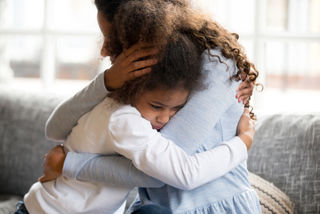
Any child feels anxious once in a while.
But when anxiety gets in the way every day, children become irritable and even angry. It's understandable! They're stymied and frustrated.
Especially anxious children also may develop physical symptoms--headaches or stomachaches and insomnia.
One in three children develops symptoms of a disorder, with a higher risk of becoming an anxious adult.
As much as we might want to think otherwise as parents, serious untreated anxiety doesn’t just go away as a child matures. Instead it tends to get worse.
One good answer: Cognitive behavioral therapy, which teaches healthy ways to cope with worries and emotions. About half of all children who receive the therapy respond.
But if your child falls into the other half, or therapy isn’t an option, you can step in as the parent and improve her symptoms. The key is not to give in to her fear.
Children turn to parents for reassurance and protection, and it is loving to soothe your child. However, some strategies backfire. Parents of anxious children almost always try to accommodate their child, notes Eli Lebowitz, associate director of the Anxiety and Mood Disorders Program at the Yale Child Study Center.
For example, if your child is anxious socializing, you might keep visitors away from the house or stick to situations with one other familiar child. You avoid a bad afternoon--but you haven't helped your child learn to socialize.
Sadly, you've made the problem worse. Avoiding triggers for our fear makes our fear grow.
A new program called SPACE developed at Yale gives parents better ways to help their children overcome fears. In a recent study, the program did equally well when compared to CBT for children ages 7 to 14 with diagnosed anxiety disorders. One set of children received the CBT; in another group the parents were enrolled in 12 weekly counseling sessions. One parent who was sending a child dozens of texts a day gradually cut back to two or three. Instead of keeping children home with stomach aches, parents learned to reassure them and send them to school.
It’s important not to ignore anxiety in children, Lebowitz said. “Severe anxiety is a serious condition which damages children, disrupts family life, and in some cases leads to suicide,” he said.
In CBT, children learn to understand how their fear is taking over their lives and then face the triggers for their fears, in baby steps. If your daughter thinks spinach is deadly, she might eat a tiny bit, and work up to more. This approach, called exposure therapy, can work for separation anxiety, obsessive-compulsive disorder (OCD), and social anxiety as well as phobias like the fear of spinach.
Jerry Bubrick, director of the Obsessive-Compulsive Disorder Service at the Child Mind Institute in New York, encourages children to give the “bully in the brain” a name and talk back to him. “Kids I’ve worked with have called him the Witch, Mr. Bossy, Chucky, the Joker, and, in the case of some teenagers, names I cannot repeat here,” he wrote.
A counsellor might work with your child to establish the baby steps. “We might ask a child with contamination fears, for example, “On a scale of 1 to 10, how difficult would it be to touch the door handle with one finger? To touch and open the door?,”” Bubrick wrote.
“Fear, like any sensation, diminishes over time, and children gain a sense of mastery as they feel the anxiety wane,” he noted.
For a child with social anxiety, for instance, the counsellor might go outside with her, with both of you wearing silly hats.
Treatment for mild to moderate cases usually takes eight to 12 sessions. Your child might also take medication at the same time.
A version of this story appears on Your Care Everywhere.


